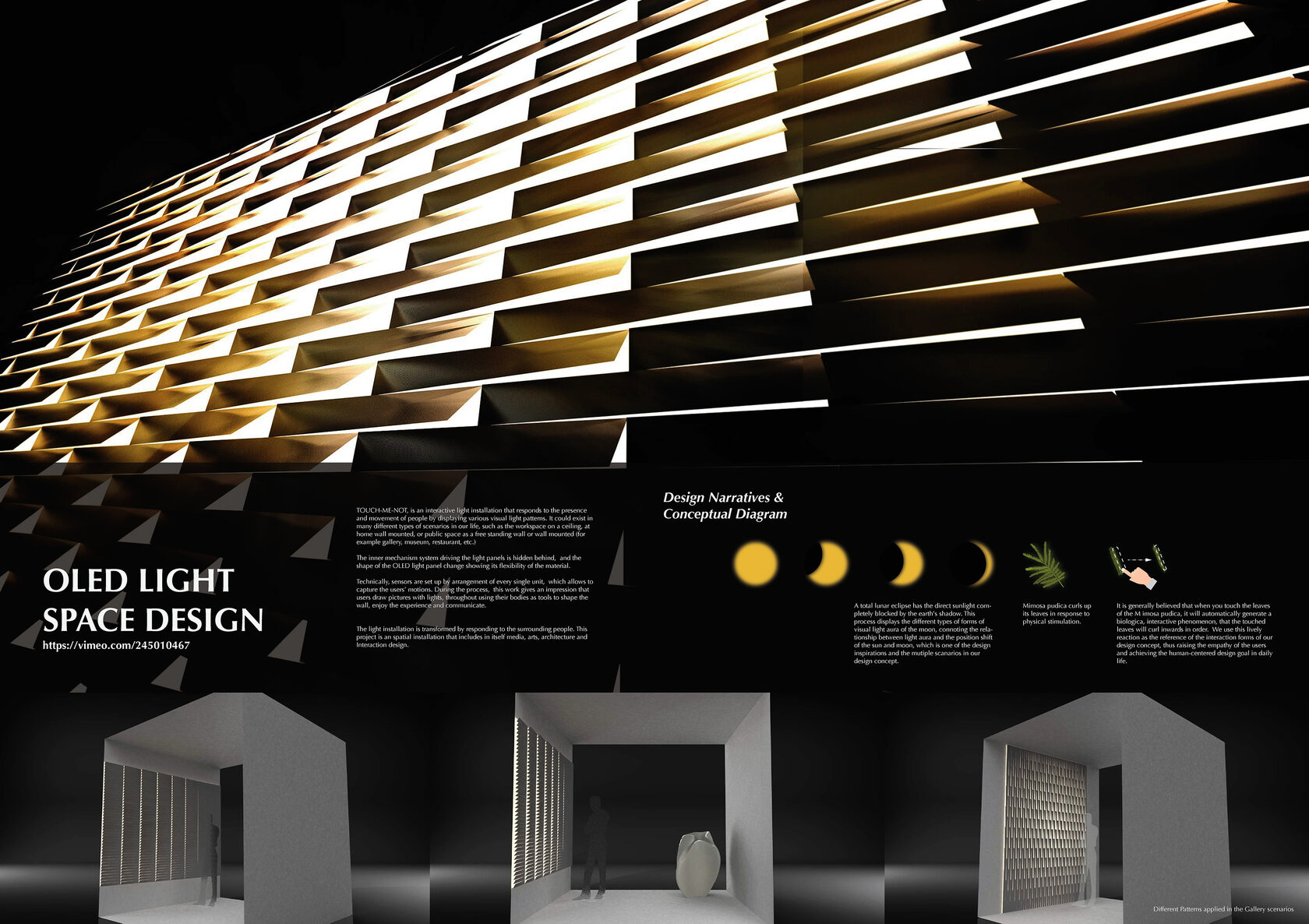
LG Space Design, London, UK
Team
Leonid Krykhtin
Meng Zhang
Xiang Guo
Yuguo Liu
Meng Zhang
Xiang Guo
Yuguo Liu
Dates
2017
TOUCH-ME-NOT, is an interactive light installation that responds to the presence and movement of people by displaying various visual light patterns. It could exist in many different types of scenarios in our life, such as the workspace on a ceiling, at home wall mounted, or public space as a free-standing wall or wall mounted (for example gallery, museum, restaurant, etc.). The installation was chosen as the only team from UK who got into the final stage of the competition.
The inner mechanism system driving the light panels is hidden behind, and the shape of the OLED light panel change showing its flexibility of the material.
Technically, sensors are set up by arrangement of every single unit, which allows to capture the users’ motions. During the process, this work gives impression that users draw pictures with lights, throughout using their bodies as tools to shape the wall, enjoy the experience and communicate.
The light installation is transformed by responding to the surrounding people. This project is a spatial installation that includes media, arts, architecture, and Interaction design. The OLED light panels change its shape by responding to human presence and movement in a room.
When a person leaves the space the lighting panels close. Once a person come in the light is turning on by opening the flexible panels in response to a person.
The OLED panels can also respond to the natural daylight conditions outside. When it is dark outside the panels open and switch on. When it is daytime, the panels close and switch off.
Each panel is consisted of 3 layers including the lighting panel, the reflecting layer, and the mechanism layer. After a digital signal is generated by the users’ movement, the servo underneath will be triggered to hold up the corner of the lighting panel accordingly.
Since the lighting surface is facing towards the wall, the density and angle of the light can be affected and controlled by the mechanism. At a larger scale, panels form into a complex space installation which will create countless options of patterns and reveal the flexibility of the lighting panel.
The inner mechanism system driving the light panels is hidden behind, and the shape of the OLED light panel change showing its flexibility of the material.
Technically, sensors are set up by arrangement of every single unit, which allows to capture the users’ motions. During the process, this work gives impression that users draw pictures with lights, throughout using their bodies as tools to shape the wall, enjoy the experience and communicate.
The light installation is transformed by responding to the surrounding people. This project is a spatial installation that includes media, arts, architecture, and Interaction design. The OLED light panels change its shape by responding to human presence and movement in a room.
When a person leaves the space the lighting panels close. Once a person come in the light is turning on by opening the flexible panels in response to a person.
The OLED panels can also respond to the natural daylight conditions outside. When it is dark outside the panels open and switch on. When it is daytime, the panels close and switch off.
Each panel is consisted of 3 layers including the lighting panel, the reflecting layer, and the mechanism layer. After a digital signal is generated by the users’ movement, the servo underneath will be triggered to hold up the corner of the lighting panel accordingly.
Since the lighting surface is facing towards the wall, the density and angle of the light can be affected and controlled by the mechanism. At a larger scale, panels form into a complex space installation which will create countless options of patterns and reveal the flexibility of the lighting panel.
LG Space Design, London, UK
Team
Leonid Krykhtin
Meng Zhang
Xiang Guo
Yuguo Liu
Meng Zhang
Xiang Guo
Yuguo Liu
Dates
2017
TOUCH-ME-NOT, is an interactive light installation that responds to the presence and movement of people by displaying various visual light patterns. It could exist in many different types of scenarios in our life, such as the workspace on a ceiling, at home wall mounted, or public space as a free-standing wall or wall mounted (for example gallery, museum, restaurant, etc.). The installation was chosen as the only team from UK who got into the final stage of the competition.
The inner mechanism system driving the light panels is hidden behind, and the shape of the OLED light panel change showing its flexibility of the material.
Technically, sensors are set up by arrangement of every single unit, which allows to capture the users’ motions. During the process, this work gives impression that users draw pictures with lights, throughout using their bodies as tools to shape the wall, enjoy the experience and communicate.
The light installation is transformed by responding to the surrounding people. This project is a spatial installation that includes media, arts, architecture, and Interaction design. The OLED light panels change its shape by responding to human presence and movement in a room.
When a person leaves the space the lighting panels close. Once a person come in the light is turning on by opening the flexible panels in response to a person.
The OLED panels can also respond to the natural daylight conditions outside. When it is dark outside the panels open and switch on. When it is daytime, the panels close and switch off.
Each panel is consisted of 3 layers including the lighting panel, the reflecting layer, and the mechanism layer. After a digital signal is generated by the users’ movement, the servo underneath will be triggered to hold up the corner of the lighting panel accordingly.
The inner mechanism system driving the light panels is hidden behind, and the shape of the OLED light panel change showing its flexibility of the material.
Technically, sensors are set up by arrangement of every single unit, which allows to capture the users’ motions. During the process, this work gives impression that users draw pictures with lights, throughout using their bodies as tools to shape the wall, enjoy the experience and communicate.
The light installation is transformed by responding to the surrounding people. This project is a spatial installation that includes media, arts, architecture, and Interaction design. The OLED light panels change its shape by responding to human presence and movement in a room.
When a person leaves the space the lighting panels close. Once a person come in the light is turning on by opening the flexible panels in response to a person.
The OLED panels can also respond to the natural daylight conditions outside. When it is dark outside the panels open and switch on. When it is daytime, the panels close and switch off.
Each panel is consisted of 3 layers including the lighting panel, the reflecting layer, and the mechanism layer. After a digital signal is generated by the users’ movement, the servo underneath will be triggered to hold up the corner of the lighting panel accordingly.
Since the lighting surface is facing towards the wall, the density and angle of the light can be affected and controlled by the mechanism. At a larger scale, panels form into a complex space installation which will create countless options of patterns and reveal the flexibility of the lighting panel.


















